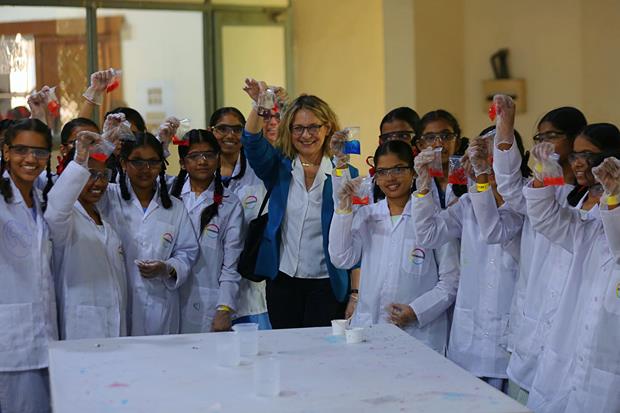Girl child education is a joke in our country. Girls bear the burden of cooking and cleaning growing up yet are considered a burden. Most girls in rural areas still don’t go to school, leave alone higher education. In fear of exploitation and abuse, many girls are not sent to school and kept at home only to be married off early, continuing the cycle of dependence and discrimination from their families and society at large. Education is the way out.
Girl child education is key to empowerment
It is ironic that people across socio-economic strata think that investing in a girl child’s education is a waste of money but will borrow and spend on their daughter’s marriage expenses or dowry instead. When a girl is educated, she is empowered. She can make decisions for herself, raise the standard of living for her family and children, become economically independent, and reform society as a whole. Strategic CSR projects of Covestro, Intuit India and Mahindra Group are not only changing the mindset towards girl child education in India, but also building ecosystems for young girls to get the quality education and respect they deserve.
1. Project Nanhi Kali
There are millions of girls in India who are denied education, and inequality persists with poor female literacy levels, high dropout rates for girls and poor learning levels. Project Nanhi Kali is one of India’s largest girl child education programmes that enable girls from economically and socially disadvantaged backgrounds to complete their schooling.
The CSR project is jointly managed by KC Mahindra Education Trust and the Naandi Foundation. Each girl is provided with a 360-degree academic as well as material support through an annual school supply kit consisting of a school bag, uniforms, stationery, female hygiene material, etc. Nanhi Kali’s academic support centres engage girls in concept-based learning through a specially designed pedagogy for two hours on a daily basis.
Digital tablets with pre-loaded audio-visual educational content are provided to girls studying in secondary school (6th-10th grades). The project also works extensively with the families of the girls and engages with community stakeholders to sensitise them on the importance of girl child education and build safe, conducive female-friendly ecosystems.
Impact
Since its inception, Project Nanhi Kali has provided access to quality education to over 3,50,000 underprivileged girls. A reduction in the dropout rate has been recorded with a high retention rate of around 90%. Girls have shown improved learning levels year on year, which is being monitored through individual assessments. The CSR project has also successfully created a safe ecosystem and environment for underprivileged school girls.
On the occasion of Raksha Bandhan, Project Nanhi Kali has started #ShikshaBandhan for donors to empower young sisters with the gift of education.
2. Konecranes – Girl Child Education Project
The Girl Child Education Programme (GCEP) was an initiative of the NGO IIMPACT, which is the CSR partner of Konecranes and Demag Private Limited. GCEP aimed to empower and mobilise young girls between the age group of 6-14 years by providing quality primary education up to the 5th grade. It also intended to increase access and enrolment to basic primary education through community mobilisation and subsequent transition into secondary education post completion of the 5th grade.
The target beneficiaries were girls who were out of the formal schooling system and belonged to the socially disadvantaged and economically marginalised rural communities in India. GCEP was implemented by establishing model learning centres across rural India for a period of five-six years. These were only teacher-led centres, imparting primary level education to girl children using Multi-Grade Multi-Level (MGML) grouping. The MGML grouping was done due to infrastructure and pedagogical reasons, and the system provided training to children based on their level of learning, competencies and capabilities.
The centre ran till the time all the enrolled girls achieved a firm grounding in primary education. The teachers and supervisors at these learning centres underwent training every quarter to ensure standard quality delivery of knowledge across all centres. The programme also encouraged setting up of centre management committees in every village to foster community ownership and promote discussion regarding girl child in the area.
Impact
This initiative has changed the outlook of girl child education in targeted areas of Uttar Pradesh and Odisha. Parents and the community, in general, are more open to the idea of providing education to the girl child in rural communities. There has been an increase in the number of girls with access to primary schools along with increased interest among girls to pursue training for longer years.
3. Covestro India – #STEM4Girls
STEM activities provide hands-on and minds-on lessons for the student. Making maths and science both fun and interesting helps the student to do much more than just learn. But the challenge arises when it comes to women making their career in STEM. UNESCO published a factsheet in March 2015 which says that women account for minority in world’s science researchers with numbers as low as 20% – 26%. With an aim of averting the situation, Covestro, in collaboration with various partners is committed to enlighten the minds of children across the world by improving awareness amongst children and teachers about the value of learning with a special focus on STEM.


